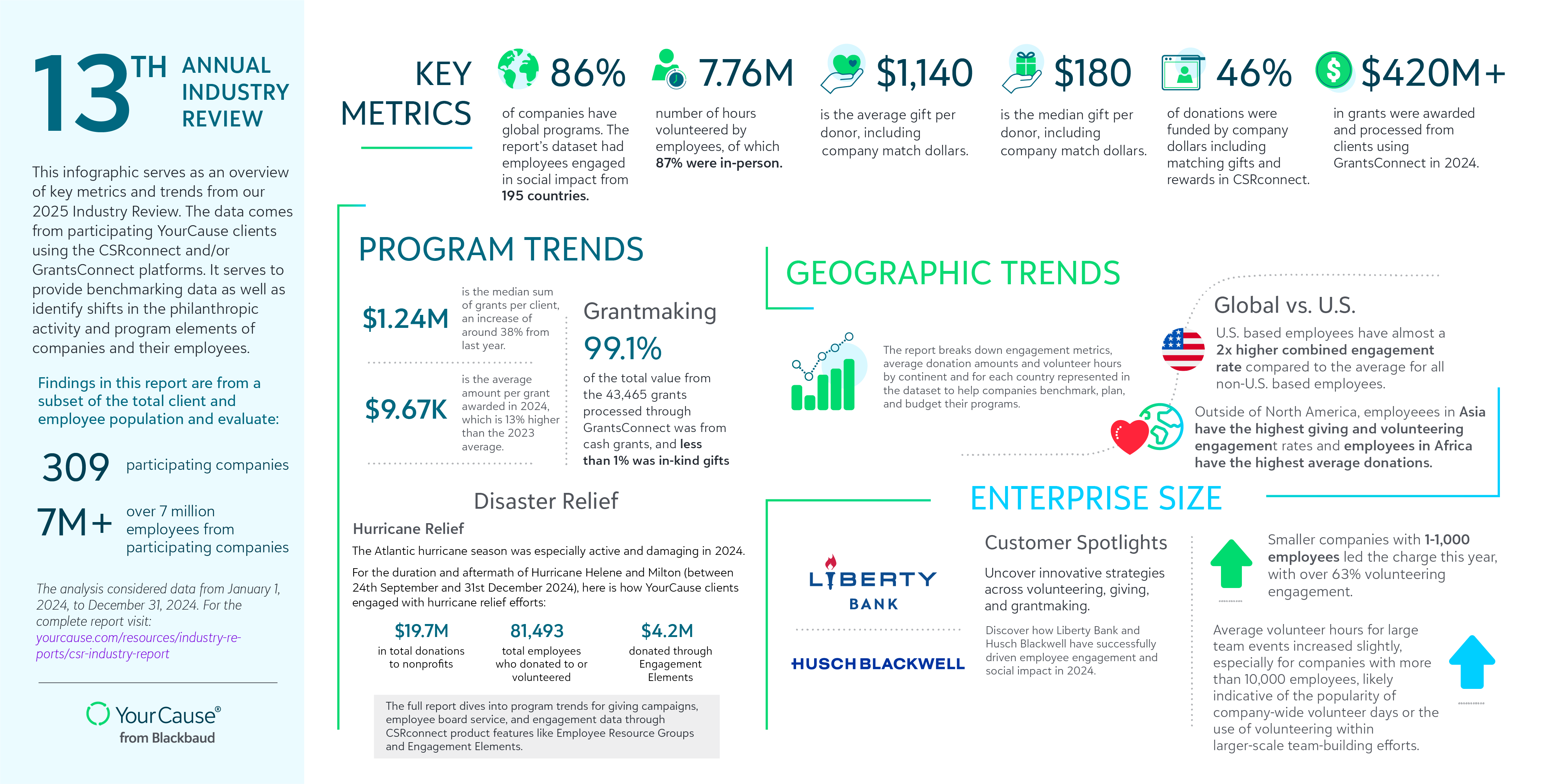11 Key Findings from the 2025 CSR Industry Review

Reflecting on the 13th edition of our YourCause CSR Industry Review, we can see that the landscape of corporate social impact is evolving, but the commitment to purpose-driven work remains strong. This annual report, drawing on data from 309 companies and more than 7 million employees worldwide, offers a rich snapshot of how organizations are engaging their people in giving, volunteering, and grantmaking. In this blog, we cover some key takeaways from the report that every CSR and employee engagement leader should be aware of.
1. Engagement Is Holding Steady, But the Donor Gap May Be Widening
While overall participation in giving and volunteering programs remained stable in 2024, the report reveals a growing disparity between large and small donors. The median employee donation declined slightly, even as the average stayed flat. This suggests that while major donors are maintaining their contributions, smaller donors may be pulling back slightly. This trend underscores the importance of designing programs that support and re-engage everyday donors.
2. Combined Programs Drive Higher Engagement
Companies offering both giving and volunteering programs saw significantly higher engagement (16.8%) than those offering only one (5.1% for giving-only, 7.3% for volunteering-only). This reinforces the value of integrated CSR strategies that give employees multiple ways to participate and connect with causes they care about.
3. Small Companies, Big Impact
Organizations with fewer than 1,000 employees led the way in volunteer engagement, boasting a 63.8% participation rate. Companies of this size also had the highest average and median volunteer hours per participant. The data suggests that smaller firms may have more agile cultures that allow for deeper community involvement—and that larger enterprises can learn from their example.
4. Payroll Giving Is the Most Engaging Donation Method
Payroll giving had the highest participation rate (6.7%) among all donation methods, outpacing credit card, offline, and incentive-based giving. It also saw the highest average and median number of transactions per donor, highlighting the power of convenience and automation in driving sustained giving behavior.
5. Global Participation Is Growing—Especially in Volunteering
International employees saw a notable increase in combined engagement, rising more than three percentage points from the previous year. Volunteering engagement among non-U.S. employees also ticked up, with Asia leading in participation and Africa showing the highest average donation amounts (driven significantly by a few very large gifts).
6. Employee Resource Groups Boost Participation
Employee Resource Groups (ERGs) continue to play a critical role in driving engagement. Companies that leveraged the Groups functionality through our CSRconnect platform saw significantly higher combined engagement rates at 18.6% compared to 15.7% for those without ERGs on the platform. Volunteering engagement was also notably higher at 13.4% versus 8.3%. These groups provide a structured way for employees to connect around shared interests and values, and they serve as powerful channels for promoting CSR initiatives, organizing events, and amplifying impact across the organization.
7. New Metrics: Median Data Adds Clarity for Benchmarking
For the first time, the report includes both average and median values for key metrics. This shift helps CSR leaders better understand typical employee behavior and avoid being misled by outliers. For example, while the average annual donation per donor was $744, the median was just $120, highlighting the importance of looking beyond averages when evaluating program performance.
8. Strategic Use of CSR Platform Features Increase Engagement
Companies that used Engagement Elements, which are interactive content tiles on the CSRconnect homepage, saw higher giving engagement (8.9%) than those that didn’t (7.3%). Similarly, incentive programs like Dollars for Doers and Cause Cards continue to be effective tools for recognizing employee contributions and encouraging participation.
9. Timely Disaster Relief Efforts Drive Impact
In response to hurricanes Helene and Milton, our clients’ employees donated nearly $20 million to relief efforts between September 24th and December 31st, with $4.2 million coming through Engagement Elements. This highlights the importance of having a rapid-response strategy and the infrastructure to mobilize support when crises strike.
At YourCause, we have established a Disaster Response Taskforce that aims to support clients with responding to disasters in a timely manner. In 2024, approximately $1.7 million went to charities that were highlighted by our Disaster Response Taskforce’s resources for Hurricane Helene and Hurricane Milton.
10. Shifts in Industry Trends: Finance, Manufacturing, and Retail
The finance and insurance sector led in volunteer engagement (22.2%) in 2024, with a seven percentage points increase. Meanwhile, manufacturing and retail were the only industries to see increases in both employee donations and company matches. These industries are proving that CSR can be a powerful lever for culture and community impact with their continual investment and program growth.
11. Grantmaking Is on the Rise
The average grant amount increased by 13%, and the median sum of grants per client rose by 38%. Nearly all grant dollars (99.1%) were awarded as cash, with just under 1% of the value of grants coming from in-kind donations. This growth reflects a maturing approach to corporate philanthropy, with companies potentially aligning with longer-term and larger sum strategic grantmaking programs.
Whether you’re building a new program or refining an existing one, here are some words from our report’s introduction letter to inspire your continued journey in creating meaningful, measurable impact.
Topics

We encourage you to take the time to explore this year’s report, reflect on its relevance to your programs, and consider how these trends align with your organization’s goals. By sharing knowledge and supporting one another, we can amplify the transformative power of our corporate social impact initiatives. Finally, I want to thank you for your dedication to this important work. As we navigate new challenges and opportunities, let us approach our efforts with PEACE—Perseverance, Evolution, Adaptation, Captivation, and Empathy. Together, we can continue driving change that transforms communities and strengthens our organizations.
Andrew J. Troup
Head of Giving and Engagement, Blackbaud



